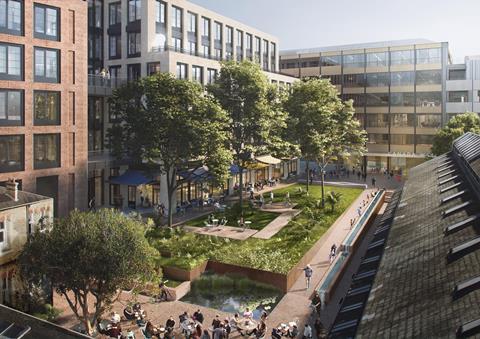Developer wants huge £3.3bn project to be fossil fuel free
Developer British Land has said its £3.3bn mixed use Canada Water scheme will be fossil fuel free to help meet its target for a net zero carbon property portfolio by 2030.
As part of this strategy, the first two buildings at Canada Water to start on site have been redesigned so these no longer need to rely on gas boilers to provide top-up heat at times of peak demand.

The mixed-use buildings are known as A1 and A2 and are designed by architect Allies and Morrison who masterplanned the whole scheme.
Wates has signed a pre-construction services agreement for the A1 building with Mace signed up for A2.
Residential buildings on the scheme will need to be all electric to meet new regulations banning gas boilers from 2025, well before the scheme’s completion date of 2034.
Last month, the government announced it wanted to bring this date forward with reports suggesting this could be as soon as 2023.
In an interview with Building Boardroom, Philip Tait, Canada Water’s head of development, said improvements in heat pump technology meant it was easier for buildings to be all electric than when the buildings were designed four years ago.
He added: “At the time these were highly sustainable but things are moving so quickly we have gone back and looked at these again and asked is this good enough now, and we don’t think it is.”
Tait added there were several challenges to overcome with the decision to go all electric including ensuring utility costs were competitive for end-users and persuading professional chefs to switch from gas cookers to induction hobs.
He said: “We may need some world class chefs to come in and cook on electric to showcase it. A change of culture is needed and we are pushing on this.”
Technology improvements are another challenge for the developer which means a flexible approach is needed for site-wide energy solutions.
Site-wide heat networks are a popular choice for large developments but Tait said he was wary about adopting one at Canada Water.
Tait said: “It’s easy to say go for a centralised heating network. We don’t know if this is exactly the right thing to do yet. We want to keep things open and flexible to do the right thing as technology changes.”
He added the emerging strategy is to trade heat between smaller islands of buildings – a couple of offices heating a few residential blocks but with the ability to link all these together. Another unknown factor that will impact on the net zero strategy is the rate at which the grid decarbonises.
British Land has also imposed a carbon levy on new development of £60 a tonne. This acts as an incentive for project teams to reduce the carbon footprint of new projects with the money used to improve the energy efficiency of the existing property portfolio.
McAleer & Rushe will carry out the final job on the first three buildings being developed at the site. Earlier this year, the Northern Irish contractor was awarded the deal for K1 – a six-storey residential block designed by Morris + Company, the former Duggan Morris which disbanded in 2017.
The Canada Water scheme will eventually turn 53 acres of rundown land in south-east London into a new town centre and 3,000 homes. In February, it overcame the last major planning obstacle when London mayor Sadiq Khan decided not to call it in.
The site, which sits between the City and Canary Wharf and is close to Canada Water Underground station, includes the abandoned Daily Mail printworks and the disused Rotherhithe police station.
The overall first phase covers 1.8 million sq ft of mixed-use space, including one million sq ft of workspace and 250,000 sq ft of retail and leisure.




























No comments yet